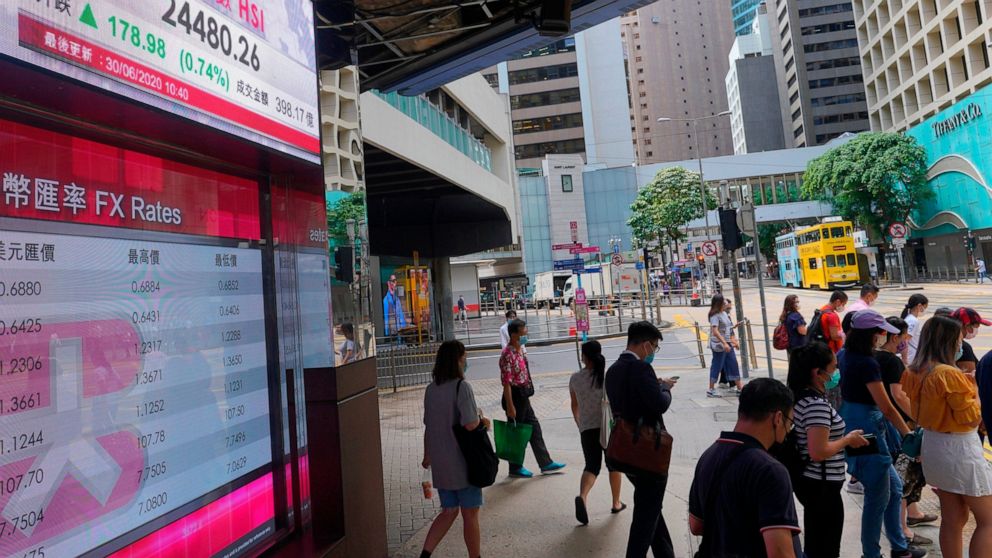Wall Street drifts as best quarter in decades comes to close
Wall Street is drifting up and down in early trading Tuesday, a quiet coda for a rocking quarter that sent the U.S. stock market nearly all the way back to its record heights
By
STAN CHOE AP Business Writer
June 30, 2020, 2:07 PM
4 min read
4 min read
NEW YORK — Wall Street is drifting up and down in early trading Tuesday, a quiet coda for a rocking quarter that sent the U.S. stock market nearly all the way back to its record heights.
The S&P 500 was up 0.2% after reversing an earlier loss of 0.2%, leaving its gain since the end of March at roughly 18%. Other stock markets around the world were mixed, while Treasury yields ticked lower and crude oil gave up a smidgen of its tremendous rebound for the quarter.
The Dow Jones Industrial Average was down 68 points, or 0.3%, at 25,527, as of 9:50 a.m. Eastern time, and the Nasdaq composite was up 0.6%.
The S&P 500 is on pace for its best quarter since 1998, but that’s only after a 20% plunge that marked its worst quarter since the 2008 financial crisis. The vicious whiplash ripped through markets as investors became increasingly hopeful that the economy can pull out of its severe, sudden recession relatively quickly.
The hopes looked prescient after reports during the quarter showed that the job market swung back to growth and retail sales rebounded as governments relaxed lockdown orders meant to slow the spread of the coronavirus.
Stocks built on gains made toward the tail end of the first quarter, when promises of massive amounts of aid from the Federal Reserve and Capitol Hill helped put a floor under the market. Low interest rates generally push investors toward stocks and away from the low payments made by bonds, and the Federal Reserve has pinned short-term interest rates at their record low of nearly zero.
But most of Wall Street says not to expect anything close to a repeat of the rocking second quarter. A rise in coronavirus infections has several states pausing their lifting of restrictions. That is seeding doubts that the economic recovery can happen as quickly as markets had forecast. Investors are setting prices for stocks now based on where they expect corporate profits to be months into the future.
Federal Reserve Chairman Jerome Powell is expected to underscore the fragility of the recovery when he testifies before a House of Representatives committee in the afternoon. He is likely to say the outlook for the U.S. economy is “extraordinarily uncertain” and success will depend largely on the country’s ability to contain the spread of the virus, according to testimony released Monday by the Fed.
Beyond the coronavirus, analysts also point to the upcoming U.S. elections and other risks that could upset markets. If Democrats sweep Capitol Hill and the White House, which many investors see as at least possible, it could mean higher tax rates, which could weaken corporate profits.
The S&P 500 has rallied back to within about 10% of its record, which was set in February, after being down nearly 34% in late March.
Crude oil has had a similar rebound, though it’s still well below where it was before the pandemic struck.
A barrel of U.S. crude oil fell 1.8% to $38.99 in Tuesday morning trading, but it’s still nearly $20 higher than where it was at the end of the first quarter. It’s also in a different world from April, when prices in one corner of the U.S. crude market briefly went below zero amid worries that collapsing demand would leave nowhere to store all the unused oil.
The yield on the 10-year Treasury dipped to 0.62% from 0.63% late Monday. But it too has rallied back from its lows when recession worries were at their height. It set a record low in March when it briefly dipped below 0.50%, according to Tradeweb. The yield tends to move with investors’ expectations for the economy and inflation.
Asian stocks began Tuesday with gains after a survey of China factory managers was better than expected, suggesting the global economy may be on the upswing after bottoming out at the height of shutdowns in April and May.
China, where the coronavirus pandemic began in December, was the first economy to reopen. But the economic data hasn’t given the all-clear yet. Global demand is still weak and Chinese consumers, worried about losing jobs, are reluctant to spend.
Japan’s benchmark Nikkei 225 gained 1.3%, South Korea’s Kospi gained 0.7% and Hong Kong’s Hang Seng gained 0.5%.
In Europe, the German DAX returned 0.1%, while the French CAC 40 fell 0.6%. The FTSE 100 in London dropped 1.2%.
———
AP Business Writer Yuri Kageyama contributed.
442 total views


